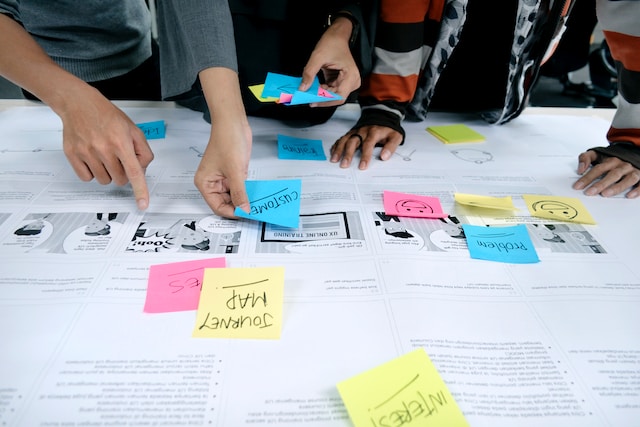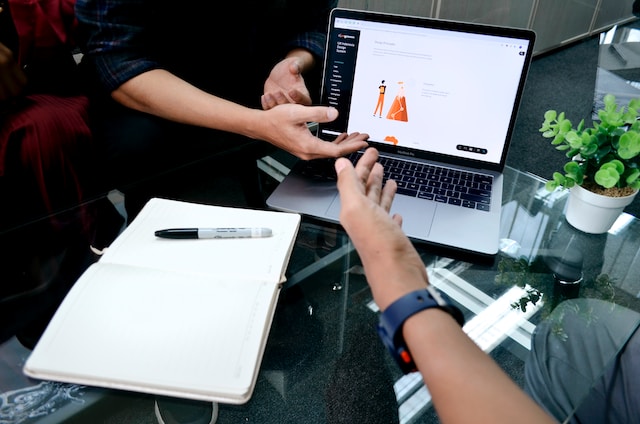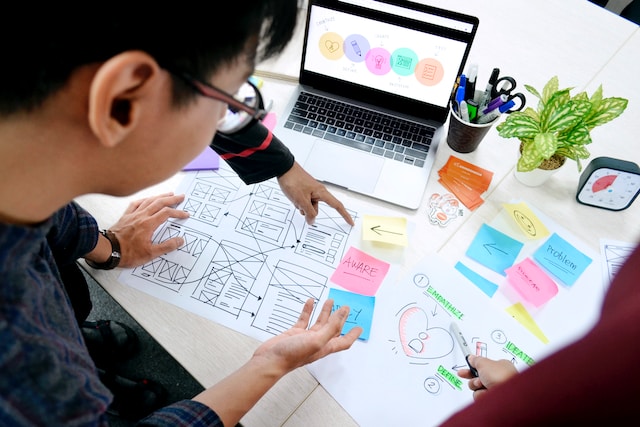A UX designer has many jobs. One of the most important is acting as a researcher, understanding what your audience needs and how to help them. Research underpins any design project, which is why it’s so important, but there are also many ways to research. The contextual interview is one of many ways to get inside your target audience’s heads, and it’s very useful.
This guide covers everything you need to know about contextual interviews for UX.

What Is a Contextual Interview?
A contextual interview involves watching and listening as your users interact with products in their own surroundings. Since they take place in a natural environment, the idea is that you receive more accurate results. It’s less formal than a lab, so the participant may be more at ease.
Another benefit is that the researcher can observe the environment. This avoids the pitfall of participants going into ‘interview mode’. It also means that the researcher can point to elements in the environment and ask the right questions.
Essentially, contextual interviews are great for gaining a holistic understanding.
Contextual Inquiry vs. Interview
The Nielsen-Norman Group refers to contextual interviews as ‘inquiries.’ You may notice other people refer to a contextual inquiry, too. So, what’s the difference between a contextual inquiry vs. an interview?
They’re the same thing. These terms are interchangeable, and both refer to the process of interviewing a participant in situ while studying their environment.
What You Learn From Contextual Interviews
Contextual interviews are useful because they combine a traditional interview with observations.
The researcher can gain an understanding of:
- What equipment does the user work with
- Issues the user is facing
- How the user sets up their space
- Preferences between different tools and applications
- The internet connection the user has
- How long it takes the user to complete common or target tasks
- Whether the user has any assistance available on-site
Why Conduct Contextual Interviews?
A contextual inquiry is part of the crucial research stage. Hugh Beyer and Karen Holztblatt developed this method as a way to drive user-centric design. Since the user is at the center of everything UX designers do, contextual interviews are a great method.
Traditional interviews have several drawbacks, including the user’s ability to remember details. Users may try to recall a process but can forget things in the moment. However, when the user is completing the process at the time, they can answer questions in much more detail.
Contextual interviews are perfect for gaining a deeper understanding. The researcher may spot things they didn’t anticipate and uncover low-level details that have become habitual for the user.
For example, many users hit the save button after completing work in Google Docs, even though it automatically saves. This means users are either unaware or they don’t trust auto-save. However, it’s such a habitual action that users may not bring this up in an interview. Being aware of this behavior can help designers create software that solves the issue.

Are Contextual Interviews Always Helpful?
Contextual interviewing is a great technique, but it’s not always useful. Targeted design tasks like redesigning product pages are often quite straightforward. Most UX professionals understand this process and don’t need to reinvent the wheel by carrying out every research technique.
Observing users go through the process can still be helpful, but the interview part will not likely be necessary.
Combining Contextual Interviews With Usability Testing
Usability testing involves users completing the same scenarios, giving you comparative data. Meanwhile, contextual interviews involve watching people’s behavior in their natural environment.
You can combine these by:
- Providing scenarios during contextual interviews and asking users to try a few of your tasks.
- Interviewing users during a usability test to find out the sorts of questions, issues, and tasks they have in mind.
As you become experienced in both techniques, you will likely find an approach that feels natural for you.
How To Perform Contextual Interviews
In a typical contextual interview, the researcher watches and listens as the user works. The inquiry takes place at the subject’s workplace or with customers during a specific moment.
The idea is to try to understand your target audience better. You can begin to understand their needs, emotions, environment, and expectations.
As they interact with the product, questions may arise. It’s the researcher’s job to investigate what’s going on and ask questions about how the user performs the task. As a result, these interviews tend to be semi-structured.
Here are four grounding principles to guide any contextual interview.
4 Grounding Principles for Contextual Interviews
Four pillars support any contextual interview.
- Context: The inquiry should take place in a natural environment. It’s important to avoid labs and conference-room settings. The researcher should carefully document the context, including time, date, season, and other notes. Also, you can be aware of the interviewees’ moods and other people in the space.
- Partnership: The user and researcher must become partners in understanding the work. Both parties are free to direct the conversation, so the researcher is not in control.
- Interpretation: The researcher must develop a shared interpretation of all important aspects of the work. The user can aid them.
- Focus: The researcher must understand the purpose of the research project so that they know what to look for. This guides the observation and interview.

Step-By-Step Guide to Contextual Interviews
Now that you know the basics of contextual interviews, here is a step-by-step guide on the process.
Part 1: Research
The first stage of any project is to research. You need to know why you are conducting contextual inquiries and also who you are targeting.
Some initial decisions you need to make include:
- Why are you researching, and if it’s exploratory or confirmatory?
- What will you do with your findings (e.g., personas and journey maps)?
- The sample size you will need.
- Identifying suitable interviewees and interview times/locations.
- How you will recruit interviewees.
Then, before you start interviewing, draw up some guidelines. Base these questions on what you want to find and the experience you want to create for the interviewee.
Part 2: The Primer
The primer is the first part of the interview, designed to put them at ease. Starting casually lets your participants become comfortable and gives them an idea of what to expect.
Begin this phase by introducing yourself and taking some time to build rapport. Explain what you hope to achieve and make it clear that the interviewee can correct any misinterpretations you may have. Then, discuss confidentiality and obtain approval for any recordings.
Part 3: The Transition
Next, it’s time to make a clear transition into the contextual interview. Explain what will happen during the rest of the session and what you need from the participant.
Make it clear that:
- The participant should expect you to interrupt when there is something to discuss.
- They can let you know if it’s a bad time to interrupt. Then, you can continue to a better stopping point.
Without this step, the participant might enter ‘interview mode’, which damages the credibility of the contextual inquiry.
Part 4: The Interview
When the interview begins, it follows a two-step pattern. The first is watching and learning, and the second is stopping to initiate discussion.
Each interview will take on its own rhythm, so try to let the flow develop. There are a few things to be especially aware of as the researcher.
- Take note if the user employs any external resources.
- Ask them about standard steps vs. uncommon variations in their processes and why this happens.
- Explain your interpretations of their tasks so the user can confirm if they are correct.
There is a delicate balance between observation and discussion. Generally, it’s best to observe the user as naturally as possible. However, you should also not be afraid to initiate discussion.
Ask questions whenever you observe something you don’t understand. In this case, ask open-ended questions so that the participant has the freedom to give details.
You should also allow the participant to validate your understanding of the user’s mental model. This prevents you from making assumptions about their process. Again, try to ask open and non-leading questions.
This will help you reveal underlying motivations that use the situational context. A contextual interview is about saying “show me” so the participant can prove what they do. This is unlike traditional interviews, where the participant might make mistakes in explaining their process.
During the interview, try to make as many unbiased observations as possible. Remember that the length and depth of the interview may differ. You may conduct several 5-minute interviews or a smaller sample of 2-3-hour interviews.
Part 5: The Wrap-Up
At the end of the interview, you have time to ask any clarifying questions. Remember, the whole point of these inquiries is so that you can employ contextual design for your product. You won’t be able to produce something that benefits your users if you don’t understand your data.
However, if you clarify everything, then you might produce a truly helpful product that beats your competitors.
Perform a quick review of your notes before you leave. Summarize what you got from the interview by explaining your interpretation of the observed processes. Then, give your users a chance to provide final clarifications and correct your understanding.
Later, write up your key learnings. Generally, it’s best to do this right after the interview while it’s fresh in your memory. If a team conducted the interview, compare notes.
Make sure you keep track of your documentation and highlight important parts. While the raw data is important, it’s also a good idea to keep a short summary of each interview. This research might come in handy later during the design and development processes.
Contextual Interview Questions
Contextual interviews are usually only semi-structured. As a result, the researcher should be open to asking a variety of questions. The scope of the interview also depends heavily on your product and what you want to gain from the interview.
Here are some examples of contextual interview questions to give you inspiration.
- What do you enjoy about this product? This helps you understand what people like about the products they use.
- What issues do you face day-to-day? Gaining an idea of their pain points means you can address them with ease.
- When might you use this product? You are watching the participant use the product at one point in time, but there may be other use cases.
- Why do you use two monitors? This is an example of a question based on an observation. It can prevent you from making assumptions about why the user is doing something. Instead, you get a more legitimate answer about their behaviors.
- Do you prefer (a) or (b)? This is an essential question if you’re comparing the models of a product or service.
- What made you choose this product over that of a competitor? You may also want to know what key decisions your target audience makes when they purchase a product or service.

Become an Expert Designer With Page Flows
Following the contextual interview, researchers and designers can collaborate to share their findings and interpret the results. Combined with additional research, you can use this data to align with what your target audience wants. Ideally, you should walk away with a shared understanding of your users’ work processes, mental models, and common behaviors.
Of course, data does not exist in a vacuum. You also need fresh ideas to make the best products. If you’re looking for design inspiration, Page Flows is here to help. Get started today to access a growing library of user flow recordings and stay up-to-date with the latest UX trends.





